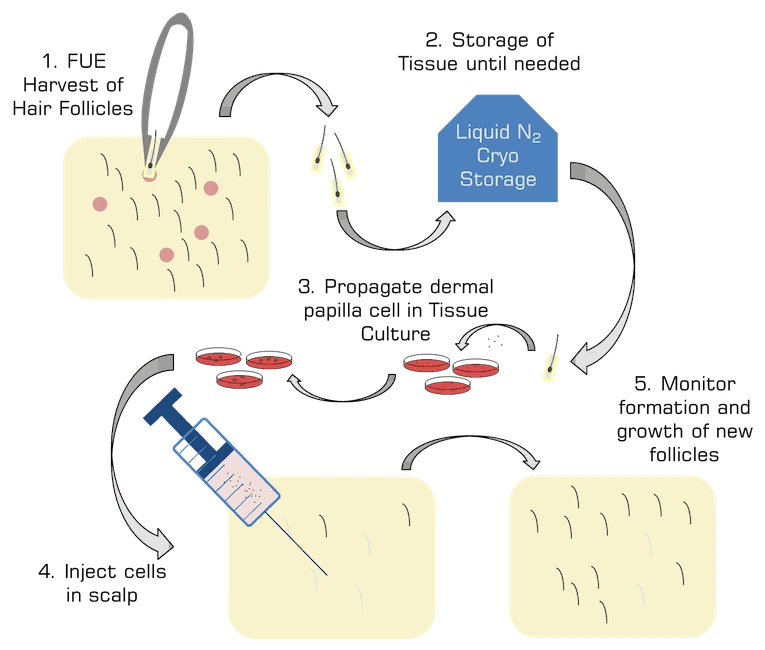Dr. Lopresti Offers Hair Follicle Banking from HairClone®
We are pleased to announce that effective immediately, our practice is offering HairClone® Hair Follicle Banking, a revolutionary concept that involves harvesting high-quality hair follicular units with the goal of cloning them and re-injecting them into the scalp. Since Leonard Hair Transplant Associates is the only practice in New England, and one of a select group of practices in the world to offer this groundbreaking experience, our patients will also be able to have their cloned cells implanted earlier, once the technology is available.
 “At Leonard Hair Transplant Associates, we pride ourselves on offering the very latest and innovative surgical and non-surgical hair-loss services and treatments,” said Dr. Matthew Lopresti, Chief Surgeon, Leonard Hair Transplant Associates. “Our partnership with HairClone® not only provides patients with a viable, future hair-loss treatment option, but also enables us to be among the first to implement hair cloning treatments once the science is perfected and available.”
“At Leonard Hair Transplant Associates, we pride ourselves on offering the very latest and innovative surgical and non-surgical hair-loss services and treatments,” said Dr. Matthew Lopresti, Chief Surgeon, Leonard Hair Transplant Associates. “Our partnership with HairClone® not only provides patients with a viable, future hair-loss treatment option, but also enables us to be among the first to implement hair cloning treatments once the science is perfected and available.”
HairClone®, the first ever follicle banking program, is based in the U.K. and is made up of world-renowned hair loss specialists, hair transplant surgeons, scientists, and biotechnologists. Hair-follicle banking can be highly beneficial for patients 45 yrs of age and under who want to thicken their thinning hair. By choosing to harvest these cells sooner rather than later, younger, healthier follicles can be banked before they start to degenerate, helping to “stop the clock” on aging hair. Similar to a woman freezing her eggs or embryos for future childbearing, hair follicle banking while younger can preserve an opportunity that may otherwise not be available due to the aging process. Grafts can be taken once a patient has noticed his/her hair starting to thin, giving patients the unprecedented option of being able to preserve their full head of natural hair.
“This revolutionary new treatment is like having an insurance plan for our patients’ hair,” said Dr. Mary Lopresti, Surgeon, Leonard Hair Transplant Associates. “Providing the option to bank hair cells that can be used later in life is another way of helping our patients treat their hair loss.”
The four-step process is very straightforward. First, patients have their hair follicles harvested in LHTA’s offices, where under local anesthesia, approximately 120 follicles from the back of the head are extracted through FUE or follicular unit excision. Surrounding hair easily hides the procedure site and there is minimal to no down time for the patient.
 Next, the extracted follicles are sent to HairClone® where they are stored using a process called cryopreservation. This helps to keep the cells alive while halting their aging process. The banked hair cells can remain banked for as long as needed, until the cloning and re-injection options are available and you are ready to move forward.
Next, the extracted follicles are sent to HairClone® where they are stored using a process called cryopreservation. This helps to keep the cells alive while halting their aging process. The banked hair cells can remain banked for as long as needed, until the cloning and re-injection options are available and you are ready to move forward.
The goal of the hair-cloning process is to grow the dermal papilla cells that have been harvested. In theory, the cells from just a few hair follicles could potentially treat thousands of thinning hairs. Once the follicles are taken from the bank, the processing step can begin. The cells will grow in culture, multiplying over the course of two to four weeks. This cloning research has been extensively tested and has shown noticeable improvement in thinning hair.
Finally, the duplicated cells would be micro-injected into a patient’s thinning areas by Dr. Lopresti or one of the LHTA hair-restoration providers in LHTA offices. The re-injection process may be needed every two to three years depending on each patient’s individual circumstances as other hair continues to thin.
If you would like to learn more about Hair Banking please contact our office by clicking here.



